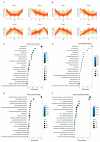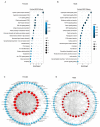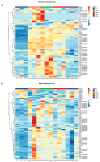Transcriptome Analysis Revealed the Early Heat Stress Response in the Brain of Chinese Tongue Sole (Cynoglossus semilaevis)
- PMID: 38200815
- PMCID: PMC10777917
- DOI: 10.3390/ani14010084
Transcriptome Analysis Revealed the Early Heat Stress Response in the Brain of Chinese Tongue Sole (Cynoglossus semilaevis)
Abstract
As a common influencing factor in the environment, temperature greatly influences the fish that live in the water all their life. The essential economic fish Chinese tongue sole (Cynoglossus semilaevis), a benthic fish, will experience both physiological and behavioral changes due to increases in temperature. The brain, as the central hub of fish and a crucial regulatory organ, is particularly sensitive to temperature changes and will be affected. However, previous research has mainly concentrated on the impact of temperature on the gonads of C. semilaevis. Instead, our study examines the brain using transcriptomics to investigate specific genes and pathways that can quickly respond to temperature changes. The fish were subjected to various periods of heat stress (1 h, 2 h, 3 h, and 5 h) before extracting the brain for transcriptome analysis. After conducting transcriptomic analyses, we identified distinct genes and pathways in males and females. The pathways were mainly related to cortisol synthesis and secretion, neuroactive ligand-receptor interactions, TGF beta signaling pathway, and JAK/STAT signaling pathway, while the genes included the HSP family, tshr, c-fos, c-jun, cxcr4, camk2b, and igf2. Our study offers valuable insights into the regulation mechanisms of the brain's response to temperature stress.
Keywords: Cynoglossus semilaevis; gene; heat shock; transcriptome.
Conflict of interest statement
The authors declare no conflict of interest.
Figures





Similar articles
-
Transcriptome of Gonads From High Temperature Induced Sex Reversal During Sex Determination and Differentiation in Chinese Tongue Sole, Cynoglossus semilaevis.Front Genet. 2019 Nov 22;10:1128. doi: 10.3389/fgene.2019.01128. eCollection 2019. Front Genet. 2019. PMID: 31824559 Free PMC article.
-
Early response to heat stress in Chinese tongue sole (Cynoglossus semilaevis): performance of different sexes, candidate genes and networks.BMC Genomics. 2020 Oct 27;21(1):745. doi: 10.1186/s12864-020-07157-x. BMC Genomics. 2020. PMID: 33109079 Free PMC article.
-
The linkage of cell cycle and DNA replication with growth difference in female Chinese tongue sole (Cynoglossus semilaevis): Analysis from transcriptomic study and WGCNA.Comp Biochem Physiol Part D Genomics Proteomics. 2021 Sep;39:100833. doi: 10.1016/j.cbd.2021.100833. Epub 2021 Apr 7. Comp Biochem Physiol Part D Genomics Proteomics. 2021. PMID: 33848768
-
Transcriptomics analysis revealing candidate networks and genes for the body size sexual dimorphism of Chinese tongue sole (Cynoglossus semilaevis).Funct Integr Genomics. 2018 May;18(3):327-339. doi: 10.1007/s10142-018-0595-y. Epub 2018 Mar 12. Funct Integr Genomics. 2018. PMID: 29532338
-
The Role of the Heat Shock Cognate Protein 70 Genes in Sex Determination and Differentiation of Chinese Tongue Sole (Cynoglossus semilaevis).Int J Mol Sci. 2023 Feb 13;24(4):3761. doi: 10.3390/ijms24043761. Int J Mol Sci. 2023. PMID: 36835170 Free PMC article.
Cited by
-
RNA-seq reveals changes in the transcriptome of the breast muscle of adult female chickens in response to heat stress.BMC Genomics. 2024 Nov 29;25(1):1158. doi: 10.1186/s12864-024-11024-4. BMC Genomics. 2024. PMID: 39614141 Free PMC article.
-
Acclimation during Embryogenesis Remodulates Telomerase Activity and Gene Expression in Baikal Whitefish Larvae, Mitigating the Effects of Acute Temperature Stress.Animals (Basel). 2024 Oct 2;14(19):2839. doi: 10.3390/ani14192839. Animals (Basel). 2024. PMID: 39409788 Free PMC article.
-
Heat Acclimation Enhances Brain Resilience to Acute Thermal Stress in Clarias fuscus by Modulating Cell Adhesion, Anti-Apoptotic Pathways, and Intracellular Degradation Mechanisms.Animals (Basel). 2025 Apr 25;15(9):1220. doi: 10.3390/ani15091220. Animals (Basel). 2025. PMID: 40362035 Free PMC article.
-
Integrating the milk microbiome signatures in mastitis: milk-omics and functional implications.World J Microbiol Biotechnol. 2025 Jan 18;41(2):41. doi: 10.1007/s11274-024-04242-1. World J Microbiol Biotechnol. 2025. PMID: 39826029 Free PMC article. Review.
References
LinkOut - more resources
Full Text Sources
Research Materials
Miscellaneous

